On the Design and Implementation of a Mixed-Platform Collaborative Virtual RAS Planner
Abstract
:Featured Application
Abstract
1. Introduction
2. Related Work
3. Materials and Methods
3.1. System Description
3.2. Architecture
3.3. Interaction
3.4. Tools for Surgery Planning
4. Experimental Study
- Short briefing about the interaction of each platform and the use of the tools.
- Free collaborative session with a 3D model segmented from a CT scan of the abdomen, where the following steps were conducted:
- First, experts #1 and #2 tested the system simultaneously for 15 min, one with the XR platform and the other with the VR platform.
- Then, experts #1 and #2 exchanged platforms and repeated the testing.
- Afterwards, experts #3 and #4 tested the system simultaneously for 15 min, one with the XR platform and the other with the VR platform.
- Finally, experts #3 and #4 exchanged platforms and repeated the testing.
- The four experts filled in an online questionnaire to assess the proposed system.
5. Results
6. Conclusions and Future Work
Author Contributions
Funding
Institutional Review Board Statement
Informed Consent Statement
Data Availability Statement
Conflicts of Interest
References
- Wirth, M.; Mehringer, W.; Gradl, S.; Eskofier, B.M. Extended Realities (XRs): How Immersive Technologies Influence Assessment and Training for Extreme Environments. In Engineering and Medicine in Extreme Environments; Cibis, T., McGregor AM, C., Eds.; Springer International Publishing: Cham, Switzerland, 2022; pp. 309–335. ISBN 978-3-030-96921-9. [Google Scholar]
- Milgram, P.; Kishino, F. A Taxonomy of Mixed Reality Visual Displays. IEICE Trans. Inf. Syst. 1994, 77, 1321–1329. [Google Scholar]
- Ens, B.; Lanir, J.; Tang, A.; Bateman, S.; Lee, G.; Piumsomboon, T.; Billinghurst, M. Revisiting Collaboration through Mixed Reality: The Evolution of Groupware. Int. J. Hum.-Comput. Stud. 2019, 131, 81–98. [Google Scholar] [CrossRef]
- Fleming, C.A.; Ali, O.; Clements, J.M.; Hirniak, J.; King, M.; Mohan, H.M.; Nally, D.M.; Burke, J. Surgical Trainee Experience and Opinion of Robotic Surgery in Surgical Training and Vision for the Future: A Snapshot Study of Pan-Specialty Surgical Trainees. J. Robot. Surg. 2021, 16, 1073–1082. [Google Scholar] [CrossRef] [PubMed]
- Hayashibe, M.; Suzuki, N.; Hashizume, M.; Kakeji, Y.; Konishi, K.; Suzuki, S.; Hattori, A. Preoperative Planning System for Surgical Robotics Setup with Kinematics and Haptics. Int. J. Med. Robot. Comput. Assist. Surg. 2005, 1, 76–85. [Google Scholar] [CrossRef] [PubMed]
- Maier-Hein, L.; Mountney, P.; Bartoli, A.; Elhawary, H.; Elson, D.; Groch, A.; Kolb, A.; Rodrigues, M.; Sorger, J.; Speidel, S. Optical Techniques for 3D Surface Reconstruction in Computer-Assisted Laparoscopic Surgery. Med. Image Anal. 2013, 17, 974–996. [Google Scholar] [CrossRef] [PubMed]
- Portalés, C.; Gimeno, J.; Salvador, A.; García-Fadrique, A.; Casas-Yrurzum, S. Mixed Reality Annotation of Robotic-Assisted Surgery Videos with Real- Time Tracking and Stereo Matching. Comput. Graph. 2023, 110, 125–140. [Google Scholar] [CrossRef]
- Checcucci, E.; Amparore, D.; Fiori, C.; Manfredi, M.; Ivano, M.; Di Dio, M.; Niculescu, G.; Piramide, F.; Cattaneo, G.; Piazzolla, P.; et al. 3D Imaging Applications for Robotic Urologic Surgery: An ESUT YAUWP Review. World J. Urol. 2020, 38, 869–881. [Google Scholar] [CrossRef] [PubMed]
- Lasser, M.S.; Doscher, M.; Keehn, A.; Chernyak, V.; Garfein, E.; Ghavamian, R. Virtual Surgical Planning: A Novel Aid to Robot-Assisted Laparoscopic Partial Nephrectomy. J. Endourol. 2012, 26, 1372–1379. [Google Scholar] [CrossRef] [PubMed]
- Kim, J.-Y.; Kim, W.S.; Choi, E.C.; Nam, W. The Role of Virtual Surgical Planning in the Era of Robotic Surgery. Yonsei Med. J. 2016, 57, 265–268. [Google Scholar] [CrossRef] [PubMed]
- Ghazi, A.; Sharma, N.; Radwan, A.; Rashid, H.; Osinski, T.; Frye, T.; Tabayoyong, W.; Bloom, J.; Joseph, J. Can Preoperative Planning Using IRISTM Three-Dimensional Anatomical Virtual Models Predict Operative Findings during Robot-Assisted Partial Nephrectomy? Asian J. Urol. 2023, 10, 431–439. [Google Scholar] [CrossRef] [PubMed]
- Emmerling, M.; Tan, H.-J.; Shirk, J.; Bjurlin, M.A. Applications of 3-Dimensional Virtual Reality Models (Ceevra®) for Surgical Planning of Robotic Surgery. Urol. Video J. 2023, 18, 100220. [Google Scholar] [CrossRef]
- Karnam, M.; Zelechowski, M.; Cattin, P.C.; Rauter, G.; Gerig, N. Workspace-Aware Planning of a Surgical Robot Mounting in Virtual Reality. In International Workshop on Medical and Service Robots; Springer: Berlin/Heidelberg, Germany, 2023; pp. 13–19. [Google Scholar]
- Laskay, N.M.; George, J.A.; Knowlin, L.; Chang, T.P.; Johnston, J.M.; Godzik, J. Optimizing Surgical Performance Using Preoperative Virtual Reality Planning: A Systematic Review. World J. Surg. 2023, 47, 2367–2377. [Google Scholar] [CrossRef]
- Chheang, V.; Saalfeld, P.; Huber, T.; Huettl, F.; Kneist, W.; Preim, B.; Hansen, C. Collaborative Virtual Reality for Laparoscopic Liver Surgery Training. In Proceedings of the 2019 IEEE International Conference on Artificial Intelligence and Virtual Reality (AIVR), San Diego, CA, USA, 9–11 December 2019; pp. 1–17. [Google Scholar]
- Kumar, R.P.; Pelanis, E.; Bugge, R.; Brun, H.; Palomar, R.; Aghayan, D.L.; Fretland, Å.A.; Edwin, B.; Elle, O.J. Use of Mixed Reality for Surgery Planning: Assessment and Development Workflow. J. Biomed. Inform. 2020, 112, 100077. [Google Scholar] [CrossRef]
- Gasques, D.; Johnson, J.G.; Sharkey, T.; Feng, Y.; Wang, R.; Xu, Z.R.; Zavala, E.; Zhang, Y.; Xie, W.; Zhang, X.; et al. ARTEMIS: A Collaborative Mixed-Reality System for Immersive Surgical Telementoring. In Proceedings of the 2021 CHI Conference on Human Factors in Computing Systems, Online Virtual, 8–13 May 2021; Association for Computing Machinery: New York, NY, USA, 2021; pp. 1–14. [Google Scholar]
- Rojas-Muñoz, E.; Cabrera, M.E.; Lin, C.; Andersen, D.; Popescu, V.; Anderson, K.; Zarzaur, B.L.; Mullis, B.; Wachs, J.P. The System for Telementoring with Augmented Reality (STAR): A Head-Mounted Display to Improve Surgical Coaching and Confidence in Remote Areas. Surgery 2020, 167, 724–731. [Google Scholar] [CrossRef]
- Sereno, M.; Wang, X.; Besançon, L.; McGuffin, M.J.; Isenberg, T. Collaborative Work in Augmented Reality: A Survey. IEEE Trans. Vis. Comput. Graph. 2022, 28, 2530–2549. [Google Scholar] [CrossRef] [PubMed]
- García-Pereira, I.; Gimeno, J.; Pérez, M.; Portalés, C.; Casas, S. MIME: A Mixed-Space Collaborative System with Three Immersion Levels and Multiple Users. In Proceedings of the 2018 IEEE International Symposium on Mixed and Augmented Reality Adjunct (ISMAR-Adjunct), Munich, Germany, 16–20 October 2018; pp. 179–183. [Google Scholar]
- Prior, F.W.; Clark, K.; Commean, P.; Freymann, J.; Jaffe, C.; Kirby, J.; Moore, S.; Smith, K.; Tarbox, L.; Vendt, B. TCIA: An Information Resource to Enable Open Science. In Proceedings of the 2013 35th Annual International Conference of the IEEE Engineering in Medicine and Biology Society (EMBC), Osaka, Japan, 3–7 July 2013; pp. 1282–1285. [Google Scholar]
- Fedorov, A.; Beichel, R.; Kalpathy-Cramer, J.; Finet, J.; Fillion-Robin, J.-C.; Pujol, S.; Bauer, C.; Jennings, D.; Fennessy, F.; Sonka, M. 3D Slicer as an Image Computing Platform for the Quantitative Imaging Network. Magn. Reson. Imaging 2012, 30, 1323–1341. [Google Scholar] [CrossRef] [PubMed]
- Wasserthal, J.; Breit, H.-C.; Meyer, M.T.; Pradella, M.; Hinck, D.; Sauter, A.W.; Heye, T.; Boll, D.T.; Cyriac, J.; Yang, S. Totalsegmentator: Robust Segmentation of 104 Anatomic Structures in Ct Images. Radiol. Artif. Intell. 2023, 5, e230024. [Google Scholar] [CrossRef] [PubMed]
- Meta Platforms, Inc., Menlo Park, CA, USA. Available online: https://www.meta.com (accessed on 10 April 2024).
- HTC Corporation, Taoyuan, Taiwan. Available online: https://www.htc.com (accessed on 10 April 2024).
- Microsoft Corporation, Redmond, WA, USA. Available online: https://www.microsoft.com (accessed on 10 April 2024).
- Unity Software Inc., San Francisco, CA, USA. Available online: https://www.unity.com (accessed on 10 April 2024).
- Photon Engine, Exit Games, Hamburg, Germany. Available online: http://www.photonengine.com/ (accessed on 10 April 2024).
- Tong, W.; Xia, M.; Wong, K.K.; Bowman, D.A.; Pong, T.-C.; Qu, H.; Yang, Y. Towards an Understanding of Distributed Asymmetric Collaborative Visualization on Problem-Solving. In Proceedings of the 2023 IEEE Conference Virtual Reality and 3D User Interfaces (VR), Shanghai, China, 25–29 March 2023; pp. 387–397. [Google Scholar]
- Intuitive Surgical, Inc., Sunnyvale, CA, USA. Available online: https://www.intuitive.com/ (accessed on 10 April 2024).
- Brooke, J. SUS-A Quick and Dirty Usability Scale. Usability Eval. Ind. 1996, 189, 4–7. [Google Scholar]
- Bangor, A.; Kortum, P.; Miller, J. Determining What Individual SUS Scores Mean: Adding an Adjective Rating Scale. J. Usability Stud. 2009, 4, 114–123. [Google Scholar]
- European Comission Technology Readiness Levels (TRL). Available online: https://ec.europa.eu/research/participants/data/ref/h2020/wp/2014_2015/annexes/h2020-wp1415-annex-g-trl_en.pdf (accessed on 10 April 2024).
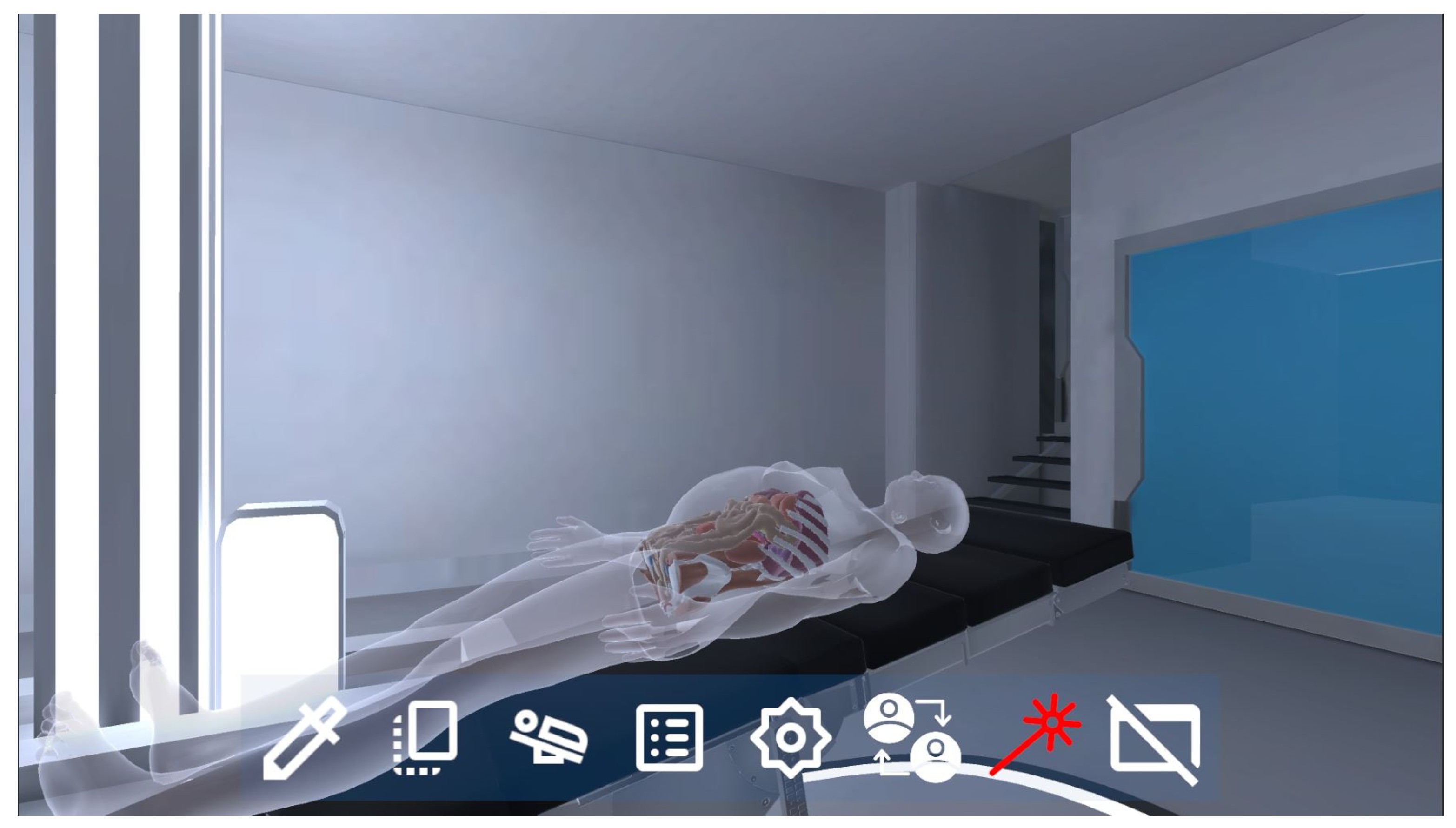
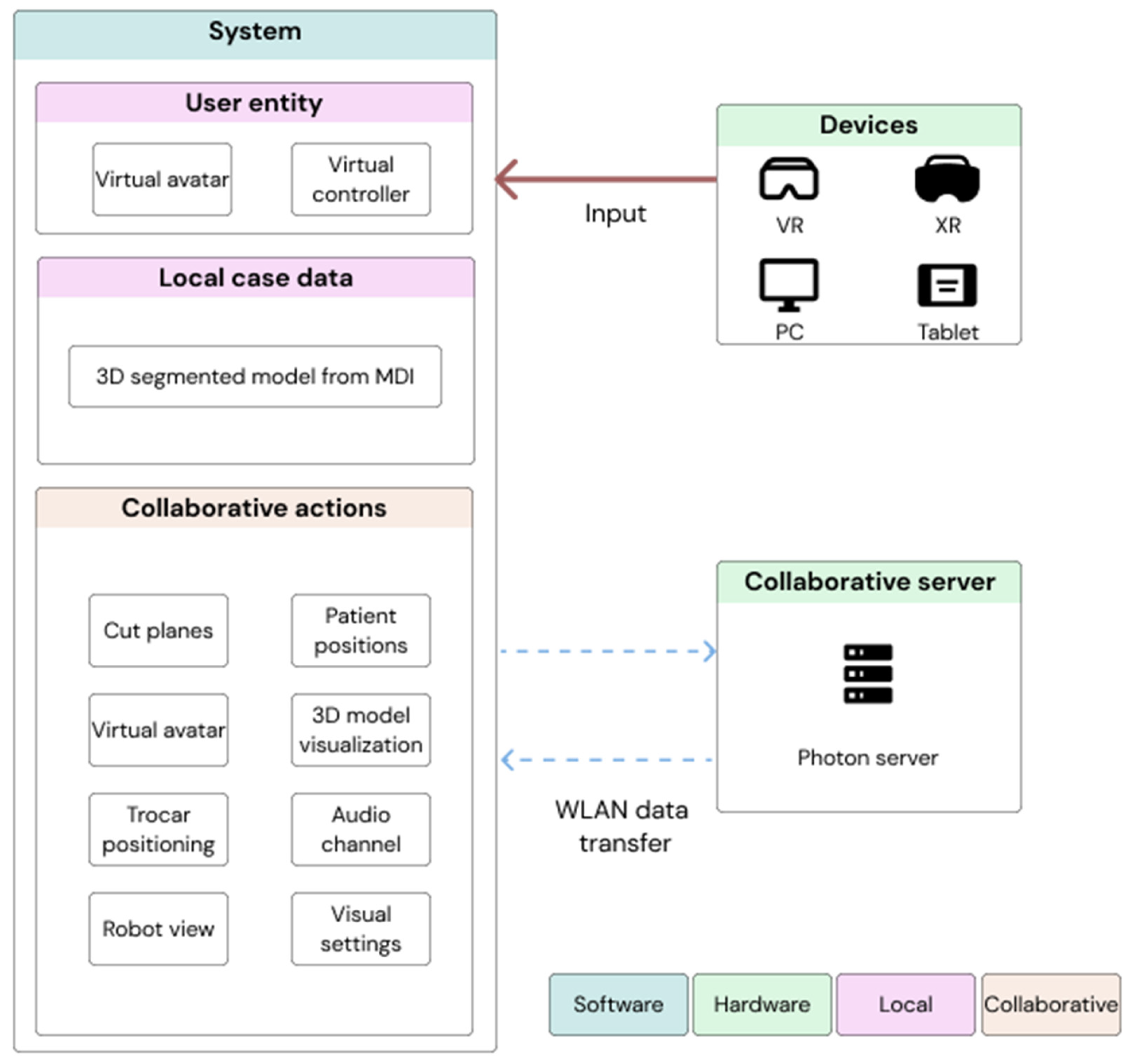
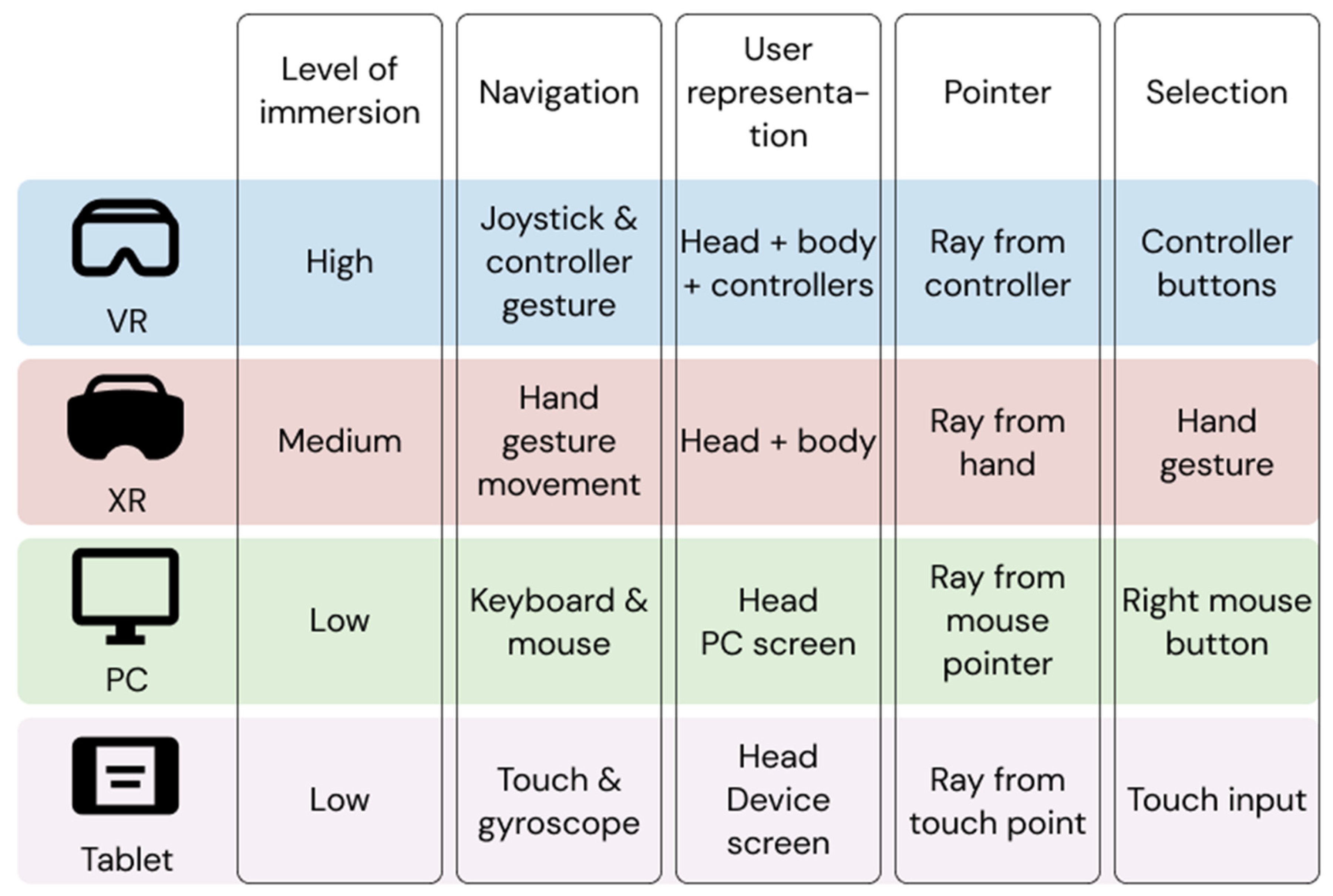
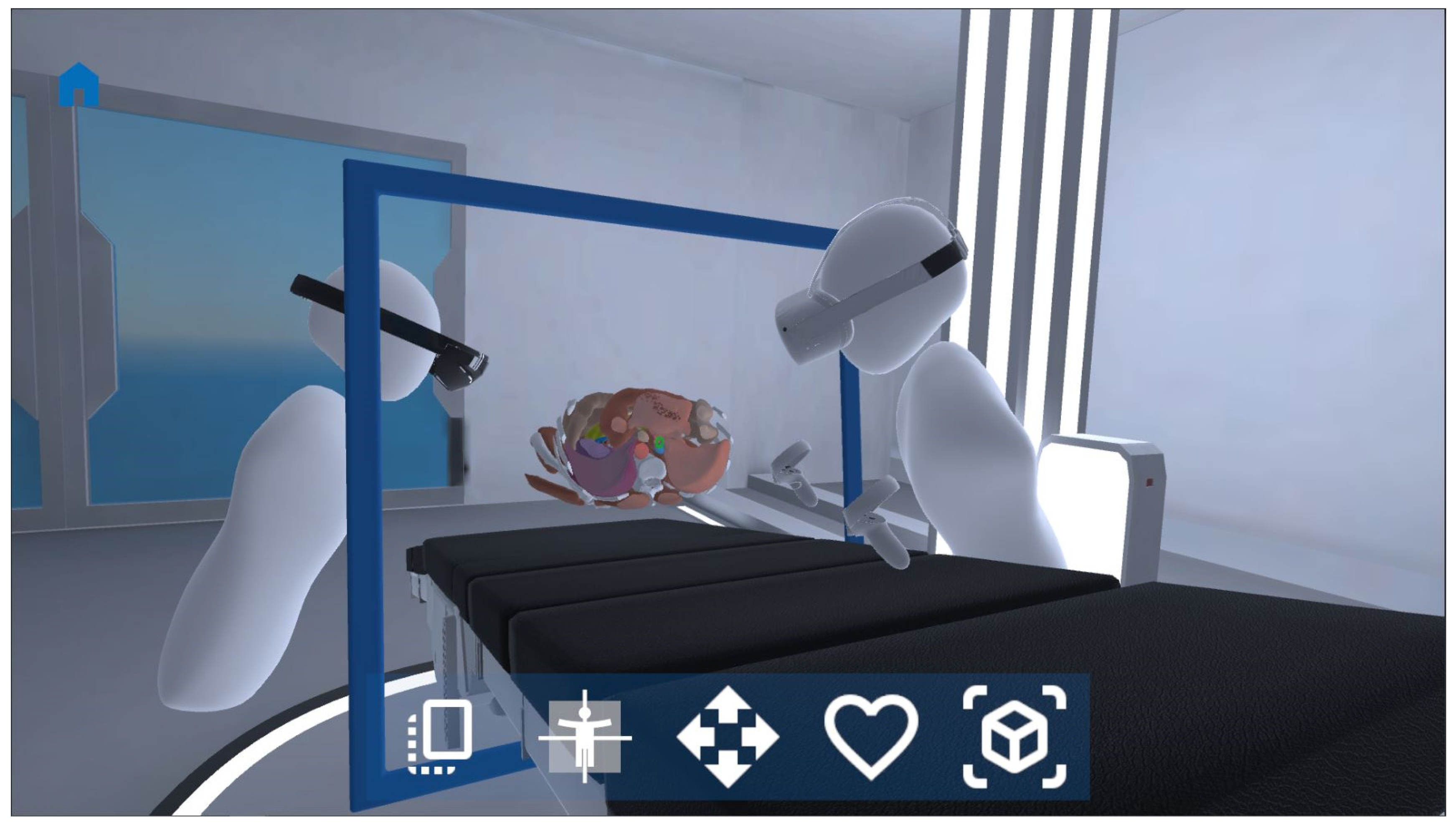
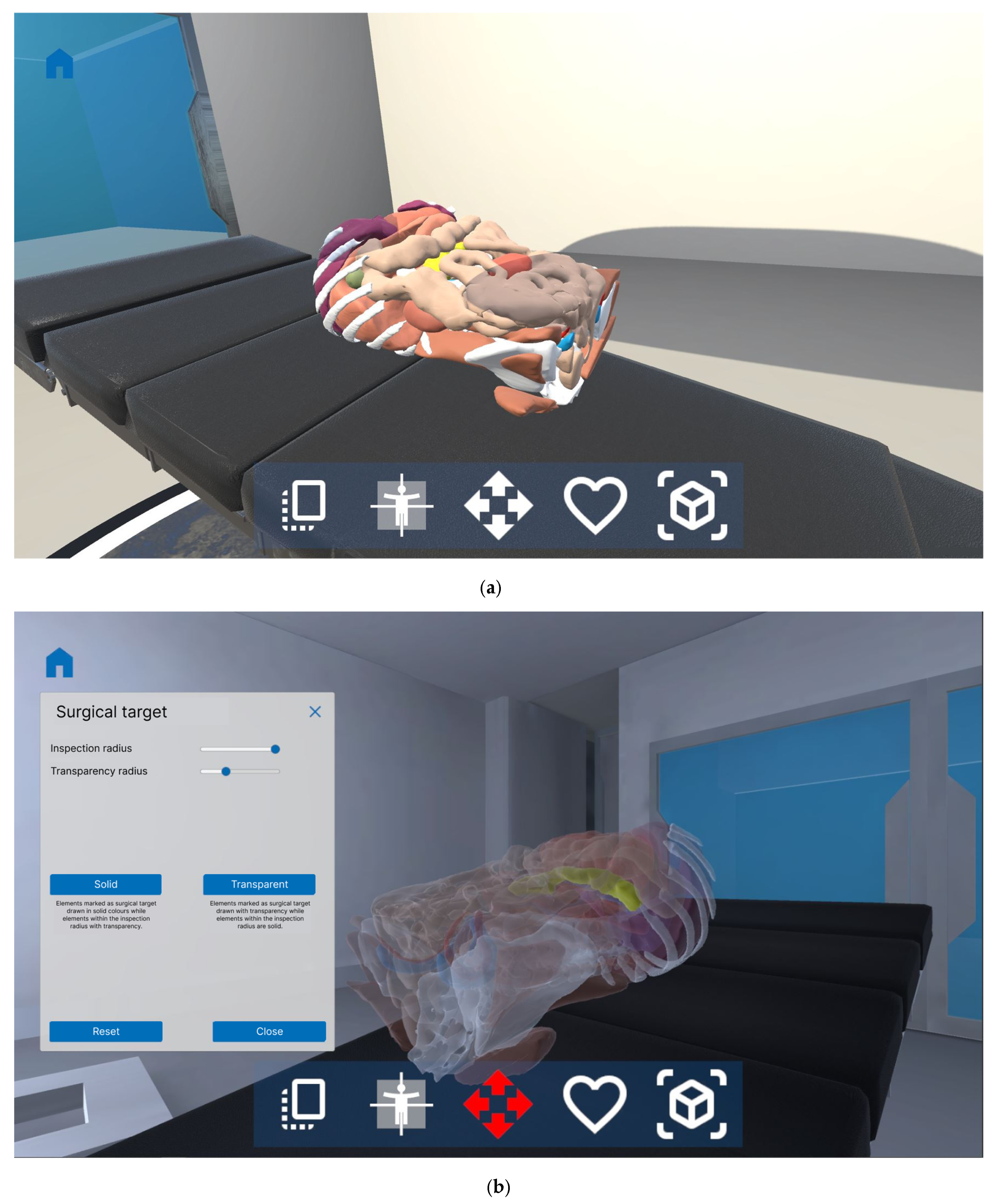


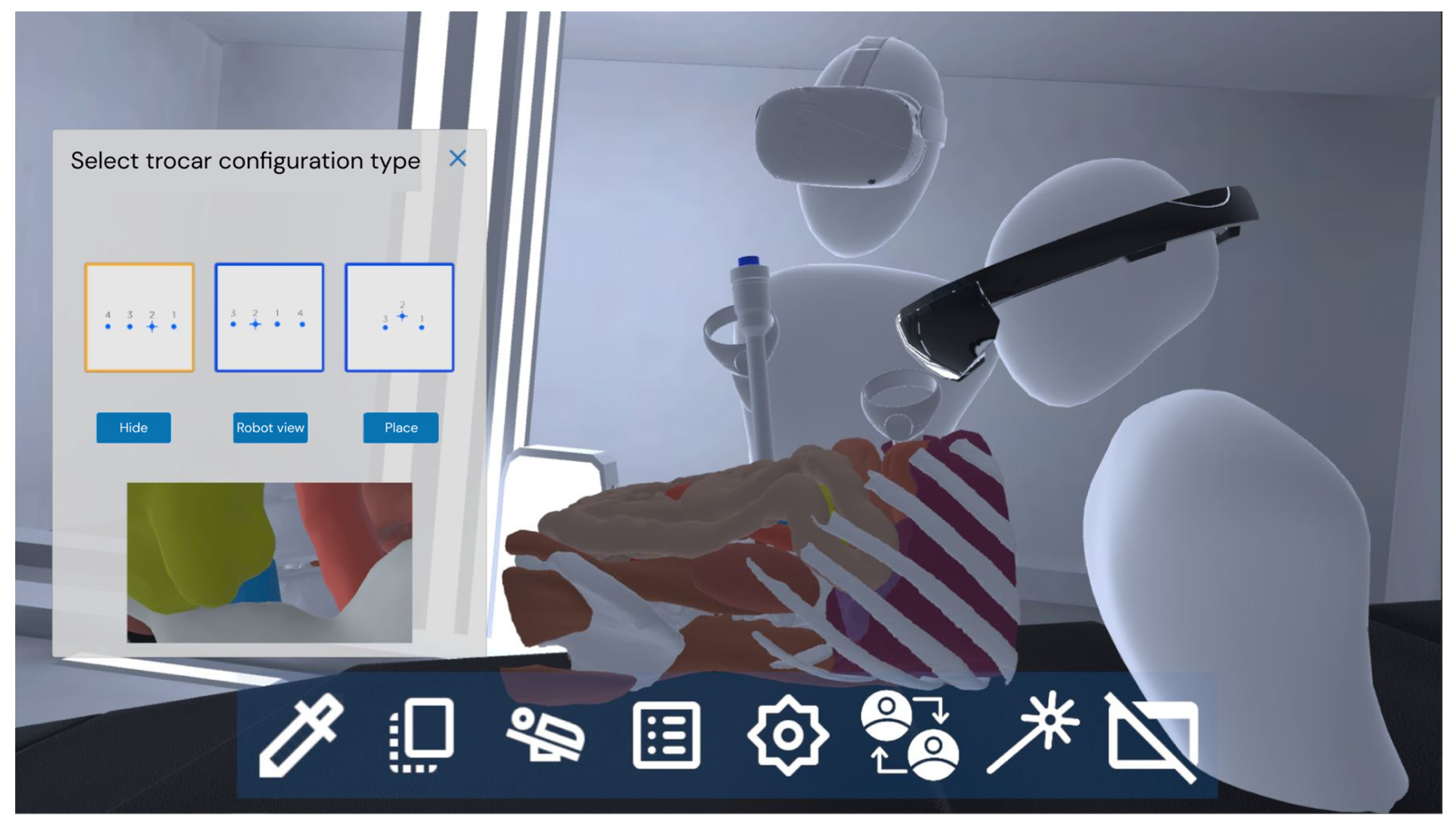

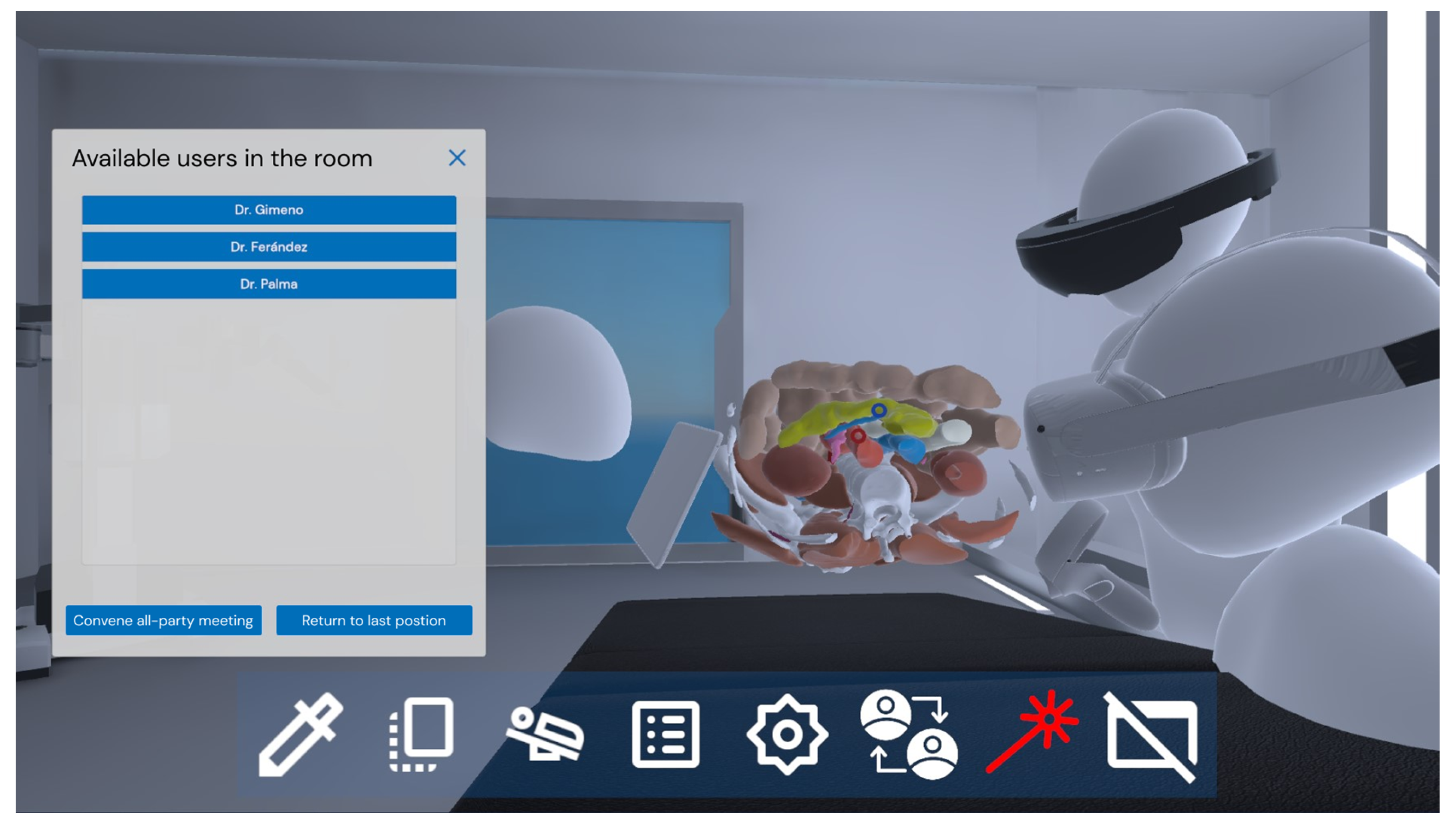

| Question | Question Text |
|---|---|
| Q1 | I think that the application could be useful for the planning of robotic surgery interventions. |
| Q2 | I have a good understanding of the virtual contents shown in the application. |
| Q3 | Collaboration between the different participants in the virtual shared space provided by the application is easy. |
| Q4 | Collaboration between the different participants in the application would allow surgeons to better coordinate their surgical planning actions with RAS. |
| Q5 | The “Section Planes” tool could be useful in surgical planning with RAS. |
| Q6 | The “Surgical Target” tool could be useful in surgical planning with RAS. |
| Q7 | The “Trocar” tool could be useful in surgical planning with RAS. |
| Q8 | My impression of the use of collaborative virtual environments in surgery has changed after having experienced the application. |
| Question | Expert #1 | Expert #2 | Expert # 3 | Expert #4 | Mean |
|---|---|---|---|---|---|
| SUS-1 | 4 | 5 | 5 | 4 | 4.50 |
| SUS-2 | 2 | 2 | 1 | 1 | 1.50 |
| SUS-3 | 4 | 5 | 3 | 5 | 4.25 |
| SUS-4 | 3 | 2 | 4 | 2 | 2.75 |
| SUS-5 | 4 | 4 | 5 | 5 | 4.50 |
| SUS-6 | 2 | 2 | 1 | 1 | 1.50 |
| SUS-7 | 4 | 4 | 3 | 4 | 3.75 |
| SUS-8 | 2 | 1 | 1 | 1 | 1.25 |
| SUS-9 | 5 | 5 | 4 | 5 | 4.75 |
| SUS-10 | 1 | 2 | 1 | 1 | 1.25 |
| SUS Score | 77.50 | 85.00 | 80.00 | 92.50 | 83.75 |
| Question | Expert #1 | Expert #2 | Expert # 3 | Expert #4 | Mean |
|---|---|---|---|---|---|
| Q1 | 7 | 7 | 7 | 6 | 6.75 |
| Q2 | 7 | 7 | 6 | 7 | 6.75 |
| Q3 | 6 | 6 | 6 | 6 | 6.00 |
| Q4 | 6 | 7 | 7 | 6 | 6.50 |
| Q5 | 7 | 6 | 7 | 7 | 6.75 |
| Q6 | 6 | 6 | 7 | 5 | 6.00 |
| Q7 | 6 | 6 | 7 | 6 | 6.25 |
| Q8 | 5 | 5 | 7 | 4 | 5.25 |
| Mean | 6.25 | 6.25 | 6.75 | 5.88 | 6.28 |
Disclaimer/Publisher’s Note: The statements, opinions and data contained in all publications are solely those of the individual author(s) and contributor(s) and not of MDPI and/or the editor(s). MDPI and/or the editor(s) disclaim responsibility for any injury to people or property resulting from any ideas, methods, instructions or products referred to in the content. |
© 2024 by the authors. Licensee MDPI, Basel, Switzerland. This article is an open access article distributed under the terms and conditions of the Creative Commons Attribution (CC BY) license (https://creativecommons.org/licenses/by/4.0/).
Share and Cite
Palma, B.; Portalés, C.; Coma, I.; Gimeno, J.; Casas-Yrurzum, S. On the Design and Implementation of a Mixed-Platform Collaborative Virtual RAS Planner. Appl. Sci. 2024, 14, 3349. https://doi.org/10.3390/app14083349
Palma B, Portalés C, Coma I, Gimeno J, Casas-Yrurzum S. On the Design and Implementation of a Mixed-Platform Collaborative Virtual RAS Planner. Applied Sciences. 2024; 14(8):3349. https://doi.org/10.3390/app14083349
Chicago/Turabian StylePalma, Belén, Cristina Portalés, Inmaculada Coma, Jesús Gimeno, and Sergio Casas-Yrurzum. 2024. "On the Design and Implementation of a Mixed-Platform Collaborative Virtual RAS Planner" Applied Sciences 14, no. 8: 3349. https://doi.org/10.3390/app14083349
APA StylePalma, B., Portalés, C., Coma, I., Gimeno, J., & Casas-Yrurzum, S. (2024). On the Design and Implementation of a Mixed-Platform Collaborative Virtual RAS Planner. Applied Sciences, 14(8), 3349. https://doi.org/10.3390/app14083349








